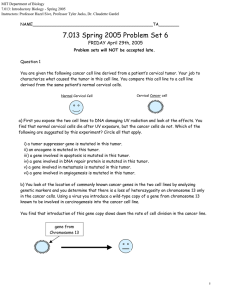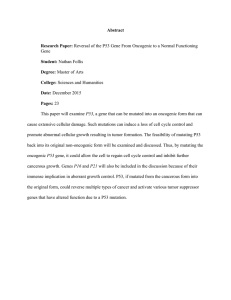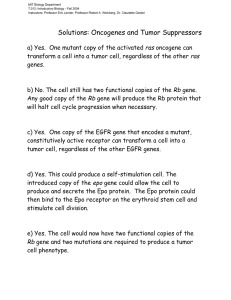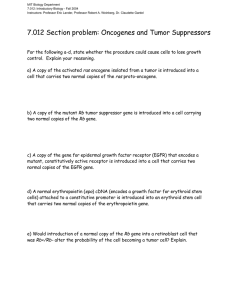MIT Department of Biology 7.013: Introductory Biology - Spring 2005
advertisement
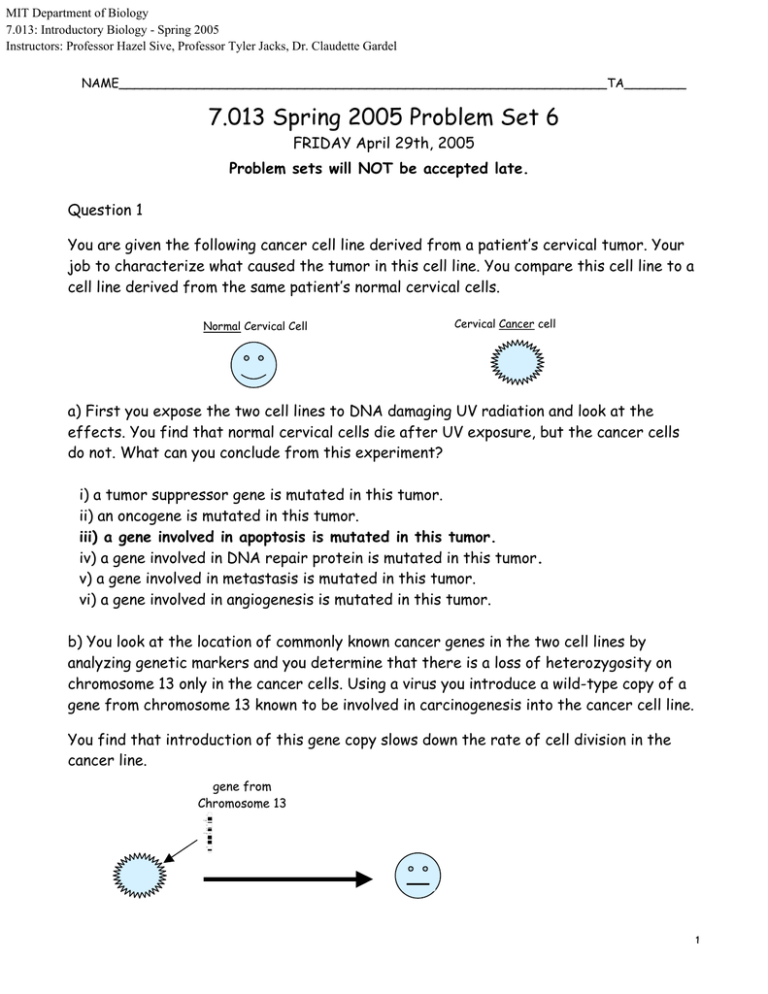
MIT Department of Biology
7.013: Introductory Biology - Spring 2005
Instructors: Professor Hazel Sive, Professor Tyler Jacks, Dr. Claudette Gardel
NAME_______________________________________________________________TA________
7.013 Spring 2005 Problem Set 6
FRIDAY April 29th, 2005
Problem sets will NOT be accepted late.
Question 1
You are given the following cancer cell line derived from a patient’s cervical tumor. Your
job to characterize what caused the tumor in this cell line. You compare this cell line to a
cell line derived from the same patient’s normal cervical cells.
Normal Cervical Cell
Cervical Cancer cell
a) First you expose the two cell lines to DNA damaging UV radiation and look at the
effects. You find that normal cervical cells die after UV exposure, but the cancer cells
do not. What can you conclude from this experiment?
i) a tumor suppressor gene is mutated in this tumor.
ii) an oncogene is mutated in this tumor.
iii) a gene involved in apoptosis is mutated in this tumor.
iv) a gene involved in DNA repair protein is mutated in this tumor.
v) a gene involved in metastasis is mutated in this tumor.
vi) a gene involved in angiogenesis is mutated in this tumor.
b) You look at the location of commonly known cancer genes in the two cell lines by
analyzing genetic markers and you determine that there is a loss of heterozygosity on
chromosome 13 only in the cancer cells. Using a virus you introduce a wild-type copy of a
gene from chromosome 13 known to be involved in carcinogenesis into the cancer cell line.
You find that introduction of this gene copy slows down the rate of cell division in the
cancer line.
gene from
Chromosome 13
1
Which of these hypotheses is consistent with this observation? (Circle all that apply.)
Chromosome 13 contains...
i) an apoptotic factor that is mutated in the cancer cell line.
ii) an oncogene that is mutated in the cancer cell line.
iii) a tumor suppressor gene that is mutated in the cancer cell line.
iv) a gene coding for a DNA repair protein that is mutated in the cancer cell line.
v) a gene required for metastasis.
vi) a gene required for angiogenesis.
c) A colleague discovered a gene that is mutated in late-stage (aggressive) cervical
tumors. He gives you a vector containing a wild-type copy of this gene that you transfect
into your original cervical cancer cell line. You observe no differences in growth, cell
death or any other properties in standard tissue culture tests.
You inject these transfected cells, as well as the original cancer cell line (not
transfected) into different groups of mice. You observe...
• Primary Tumors of similar size develop in both groups of mice.
• The original cancer cell line kills all the mice within 1 month of transfection.
• The transfected cancer cell line does not kill the mice within the 3 months of
transfection.
Which hypotheses are consistent with these observations?
The gene codes for a protein that...
i) inhibits cell division.
ii) promotes cell division.
iii) prevents apoptosis.
iv) prevents metastasis.
v) repairs DNA.
vi) promotes angiogenesis.
2
e) Since Human Papilloma Virus (HPV) infection is associated with cervical cancer, you
obtain a HPV-infected cancer cell line and a corresponding uninfected normal cell line
from a patient. You determine that there is no p53 protein in the infected cancer cells,
although the RNA is expressed normally.
When you infect the normal cell line with HPV, you find that the p53 protein levels drop
dramatically, yet the p53 RNA levels remain the same. Which of the following could
explain how HPV might be involved in cervical cancer.
i) HPV causes the degradation of the p53 protein.
ii) HPV codes for an oncogene that is expressed at high levels.
iii) HPV integrates into p53 locus, thereby knocking out the p53 gene.
iv) HPV promotes tumorigenisis by lowering the immune system of the infected patient.
v) HPV codes for a protein that degrades a DNA repair protein, leading to mutations in
the p53 gene.
vi) HPV encodes a p53 gene to be expressed at high levels.
e) Your colleague has come up with an idea to devise a gene therapy for cervical cancers
with HPV. His idea is to introduce a wild-type copy of the gene encoding the p53 gene into
the HPV infected cancer cells. Will this work?? Explain why or why not.
No it shouldn't work because any p53 protein made will be degraded as a result of HPV.
f) Iressa is a drug that was recently designed to inhibit the EGF signaling pathway. If you
were to discover that adding Iressa to cancer cells from some tumors killed them
immediately, what could you say about EGF signaling in these tumors? Choose the best
answer.
a) EGF receptor signaling in these cancer cells is needed for the cells to divide.
b) EGF receptor signaling in these cancer cells prevents apoptosis.
c) EGF receptor signaling in these cancer cells promotes cell growth and apoptosis.
d) EGF receptors from these cancer cells bind to Iressa, leading to increased EGF receptor
signaling.
3
g) In the final stages of generating Iressa, investigators performed a battery of tests to
compare various versions (a, b, c, and d) of the drug to find one with all the properties
necessary for effective therapy. Shown below are two of the tests performed. Given
that low concentrations and long duration of effective dose in the blood are most critical
in choosing a drug, from these tests, which compound would you choose as your drug?
Drug Concentration needed to be effective
a
b
c
d
-10
-9
-8
-7
-6
log of drug concentration
Concentraton of drug
100%
a
d
b
c
30 min.
ingest drug
(equal amounts)
1 hr.
10 hr.
20 hr.
time
a) drug a
b) drug b
c) drug c
d) drug d
e) all drugs are equally effective.
4
Question 2
You are biking along Mass Ave, enjoying the weather and watching the teeming masses of prospective
students. Amidst your nostalgia, you fail to notice a car-sized pothole, take a rough fall, and end up with a
nasty cut on your left knee.
a) Over the course of several hours, the cut gradually swells up and becomes red and tender. You conclude
that cells from your immune system are being recruited to the site of injury by cytokines such as
interleukins and other messenger molecules. Circle the predominant white blood cell type(s) entering the
injury region at this time.
B-cells
CD4+ Helper T-cells
CD8+ Killer T-cells
Macrophages
Mast Cells
Neutrophils
None
Two days after the initial injury, the cut is still red and swollen, as a result of white blood cells leaving the
bloodstream and entering the tissues at the injury site. This is normally caused by pro-inflammatory
cytokines that bind to receptors on the endothelial cells lining nearby blood vessels, causing these cells to
express integrin. When integrin binds its receptor the white blood cells stick on the side that faces the
bloodstream.
c) White blood cells have a receptor for the integrin, and binding to it causes them to stick to the walls of
the blood vessel, exit the bloodstream, and enter the surrounding inflamed tissue. A small number of
individuals are homozygous for an integrin deletion mutation. Which of the following effects would this
have? (Circle all correct answers.)
i) Increased bleeding time
ii) Reduced heat & swelling after an injury
iii) Increased vulnerability to bacterial infections
iv) Increased vulnerability to viral infections
v) Severe immunodeficiency: needs to live in a germ-free bubble to survive
vi) None of the above
d) Chronic granulomatous disease is a disorder caused by a mutation in the NADPH oxidase gene. With
these mutation neutrophils and macrophages can't produce the highly reactive oxygen radicals necessary
for killing phagocytosed bacteria. What are the consequences of this? (Circle all correct answers.)
i) Increased bleeding time
ii) Reduced heat & swelling after an injury
iii) Increased vulnerability to bacterial infections
iv) Increased vulnerability to viral infections
v) Severe immunodeficiency: needs to live in a germ-free bubble to survive
5
Question 3
a) Cells present antigens on MHC I and MHC II molecules. The following table lists several
different antigen types, and two different cell types that will present the antigen. For each box,
write I, II, BOTH, or NEITHER to indicate which MHC molecule(s) the cell will use to present
the antigen in the question.
Antigen
Macrophage
Muscle cell
A viral protein produced by a virus that has infected the cell.
I
I
A novel cancer protein produced within the cell.
I
A cytoplasmic protein normally found in the cell.
I
I
A protein from a phagocytosed bacterium.
II
------
A lipid from a phagocytosed bacterium.
------
----
I
b) It is known that during viral infections, viral proteins activate CD8+ T-cells via MHC I
complexes. However, CD4+ T-cells are also activated. Since CD4+ T-cells are being activated via
interactions with MHC II, what might be occurring to allow viral proteins to be expressed on
MHC II cells? MØs are phagocytosing viruses, or B cells
c) Patients with DiGeorge’s syndrome have a developmental abnormality that results in partial or
total lack of development of the thymus. These patients are capable of handling bacterial
infections, but are very vulnerable to viral infections. What types of immune cells are missing or
defective in these patients? (Circle all correct answers.)
Neutrophils
Macrophages
CD4+ T-cells
CD8+ T-cells
B-cells
None
d) HIV selectively infects and destroys CD4+ T-cells. While it is the CD8+ “Killer” T-cells that
destroy intracellular invaders, CD4+ “Helper” T-cells are required for Killer T-cell activation.
Which of the following effects would this have? (Circle all correct answers.)
i) Increased bleeding time
ii) Reduced heat & swelling after an injury
iii) Increased vulnerability to bacterial infections
iv) Increased vulnerability to viral infections
v) Severe immunodeficiency: needs to live in a germ-free bubble to survive
6
Question 4
a) Our ability to recognize a wide range of antigens depends upon the generation of a
wide variety of immune receptors. This occurs through a process called VDJ
recombination, where different combinations of DNA (the V, D, and J sequences) are
shuffled to make random receptors. Adenosine deaminase is an enzyme required in this
process, without which functional immune receptors cannot be created. What cells would
be absent or defective in a patient lacking a functional adenosine deaminase?
B-cells
CD4+ Helper T-cells
CD8+ Killer T-cells
Macrophages
Mast Cells
Neutrophils
None
Put a check in the appropriate boxes to indicate which immune receptor binds to which
antigen or antigen complex.
Antigen / Antigen Complex
B-cell
receptor
Free-floating antigens
√
CD4 T-cell
receptor
CD8 T-cell
receptor
√
Antigens presented by MHC I
√
Antigens presented by MHC II
-S
-S
-
{
-
NH2
-S
-S
Light Chain
NH2
JL
{
co
JH {
NH2
- e
en it
ig g S
nt nin
bi
m
VH{
DH{
NH2
A
Disulfide Linkage
co
A
m nti
bi ge
ni n
ng Si
te
b) The following figure shows a complete antibody protein, with two heavy chain peptides
forming a dimer in the inner part and two light chain peptides hanging on the outer part.
VL
-S-S-S-S-
Heavy Chain
Effector Site
-S-SHOOC
COOH
Figure by MIT OCW.
Light chains do not have a D segment.
7
c) If there are 300 VL segments and 5 JL segments, how many different light chains can
be produced by VJ recombination?
1500
d) If there are 200 VH segments, 15 DH segments, and 4 JH segments, how many
different heavy chains can be produced by VDJ recombination?
12000
e) If the two heavy chains have to be the same, and the two light chains have to be same,
but their VDJ recombination is independent of each other, how many different
antibodies can be produced?
1500 X 12000
= 18,000,000
f) B-cell and T-cell immune receptors are produced by undergoing an analogous VDJ
recombination process to antibody production. Each B-cell or T-cell the body makes has a
unique immune receptor. Each immune cell expresses its unique receptor, and only its
unique receptor because of.... (Circle one.)
• A unique combination of transcription factors
• A unique change in the DNA coding for the receptor
• A unique way of translating the mRNA coding for the receptor
• All receptors are produced, but only the unique receptor gets expressed at the
cell surface
g) What happens to developing T-cells that express receptors that recognize selfantigens?
apoptosis
h) What happens to mature T-cells if they express receptors that recognize selfantigens?
auto immunity or anergy
i) What happens to mature T-cells that express receptors that recognize foreign
antigens?
attack invaders
8
